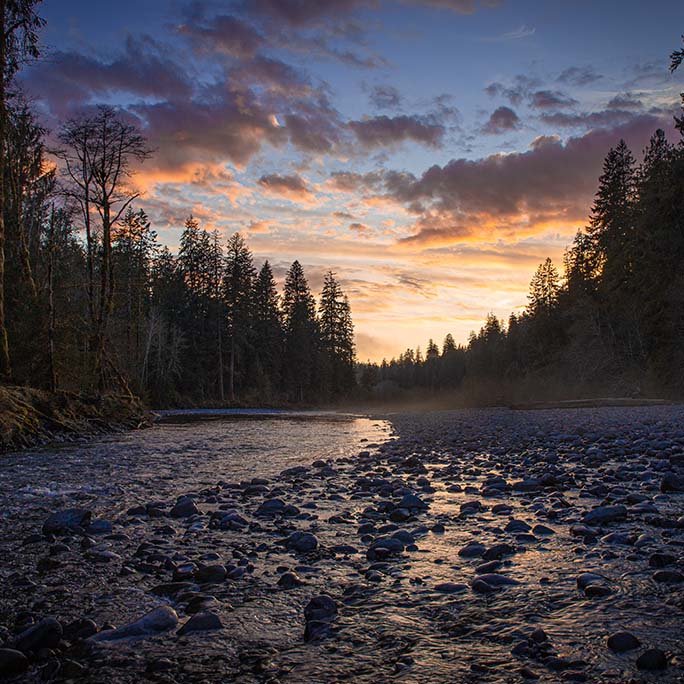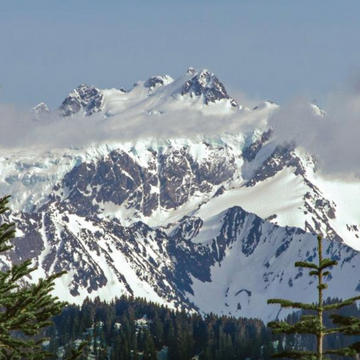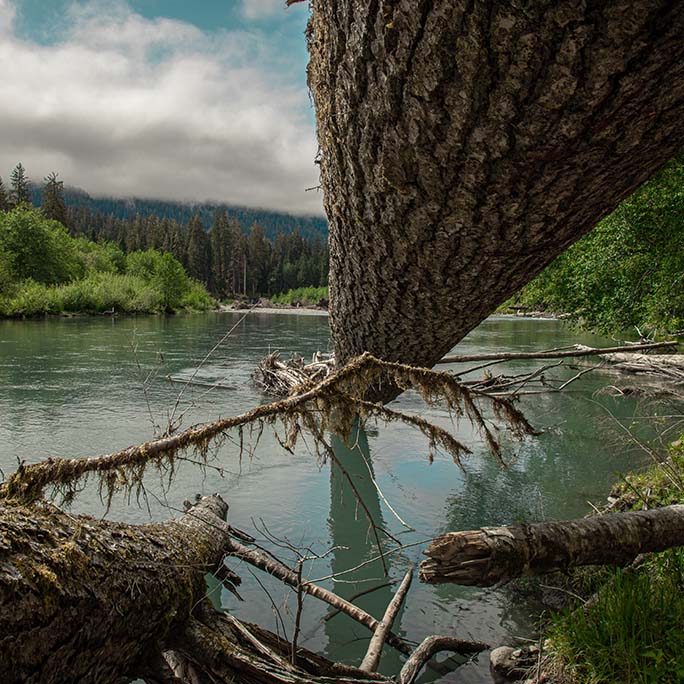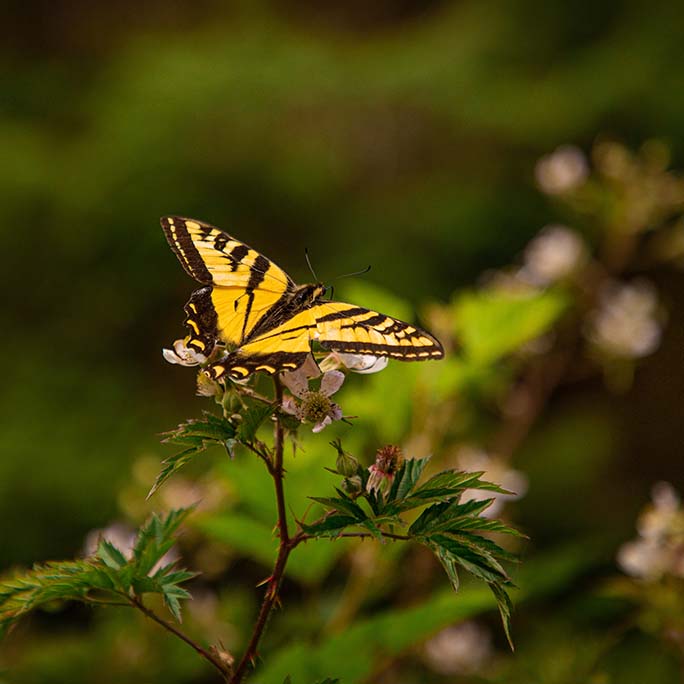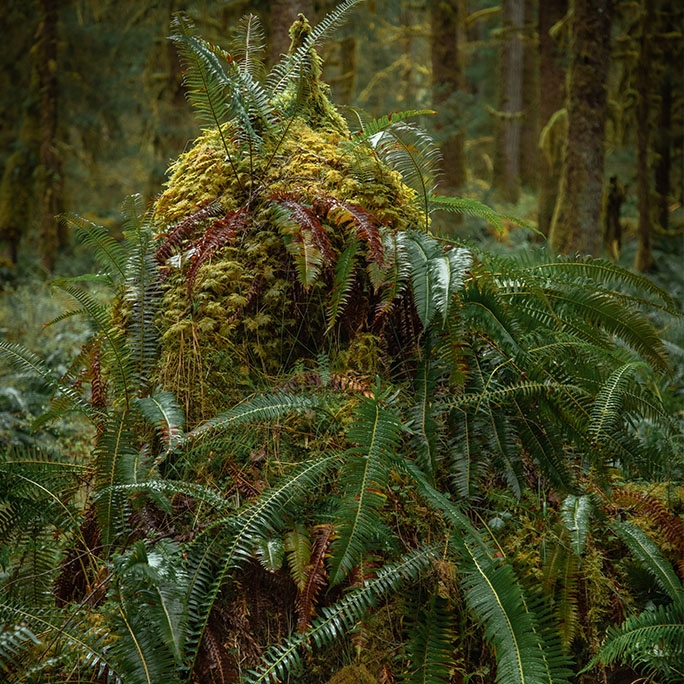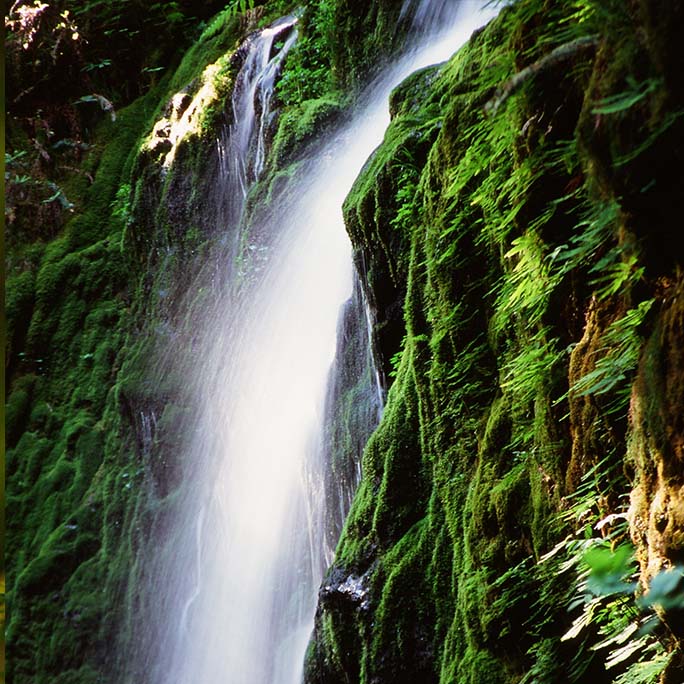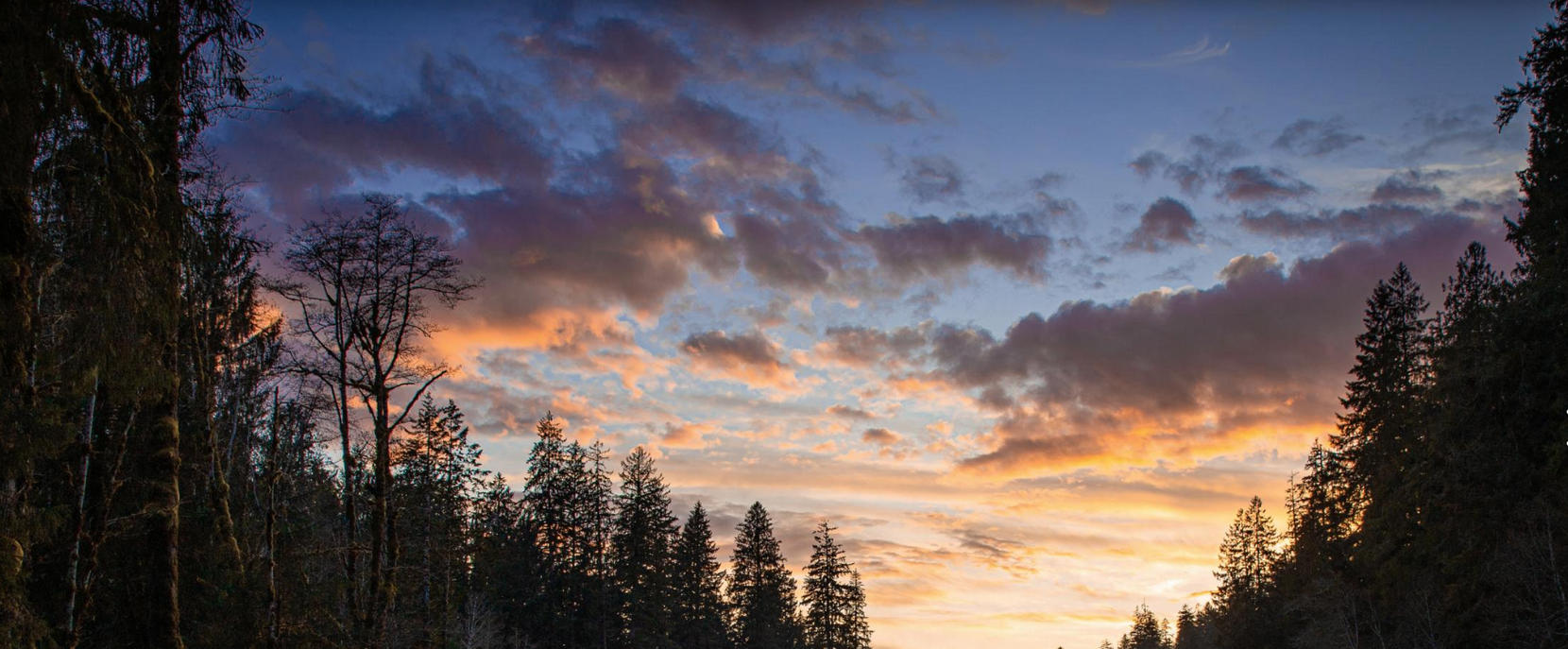
Winter 2020
Home and Free
The writer knew he'd never see the beauty of the rain forest until something melted the terror inside him. Lucky for him, he had the right guide.
- Story by Rosette Royale
- Photos by Bryant Carlin
BRYANT CARLIN SEES the natural world through shutters and clicks. This makes perfect sense. He’s a photographer—or, to be specific, a “wilderness immersion photographer,” Bryant’s way of saying he embeds himself in a remote outdoor location with a camera.
He’ll establish a basecamp, heading out each day to survey his surroundings. If he sees something on Monday that’ll make a good photo—a pristine pool of water, an elk carcass—he might wait till Tuesday or Wednesday to shoot it, when the light is better. After a couple weeks, he’ll move his basecamp and start all over again. It’s a painstaking process, one Bryant prefers to undertake alone, which is wise, because his backcountry treks can last months. Yet as soon as he leaves the wilderness, he wants to return. In the woods, he once told me, he’s free. In the woods, he’s home.
Bryant’s favorite place to shoot us Olympic National Park, a modern day Shangri-la on Washington’s Olympic Peninsula. The park encompasses close to a million acres, and within its borders exist multitudes, from mountains encrusted with glaciers to coastal zones dotted with tidal pools. Yet much as Yellowstone is known for thermal geysers and bison herds, Olympics renown rests on its temperate rain forest valleys. Those valleys are the wettest place in the continental US, receiving, on average, 10 to 12 feet of rain a year. That precipitation, combined with cool temperatures, nurtures a primeval realm comprised of a shrubby understory, dangling lichens, moss-draped bigleaf maple, and gargantuan Western hemlock and Sitka spruce. For more than 20 years, Bryant has trained his camera lens—and his eyes—on this park, paying special heed to its rain forests. He calls Olympic one of the world’s most beautiful places, and he swore, when I visited, I’d fall in love.
But when I finally joined him there, years after he first invited me, my feelings for the park amounted less to love and more to fear. Part of my terror was tied to Bryant’s furious pace. If he wasn’t hunched over his camera lining up a shot, he was bolting down the trail, his right arm clenched to his Canon-mounted tripod to keep it perched, like a soldier’s rifle, on the bridge of his shoulders. I worried we’d be separated in a place that overwhelmed my senses. The park contained so many shades of green—I couldn’t comprehend them. The air smelled new yet also centuries old. Trees stretched to such heights, they sometimes created a verdant vault where sunlight yearned to reach the forest floor. And surrounded by dense foliage, gauging distance or direction proved impossible. Nearly every marker I used to get my bearings in Seattle, where I lived, became useless in the rain forest. Forget trying to enjoy its majesty: I just wanted to go home.
I was too embarrassed to tell Bryant how I felt.
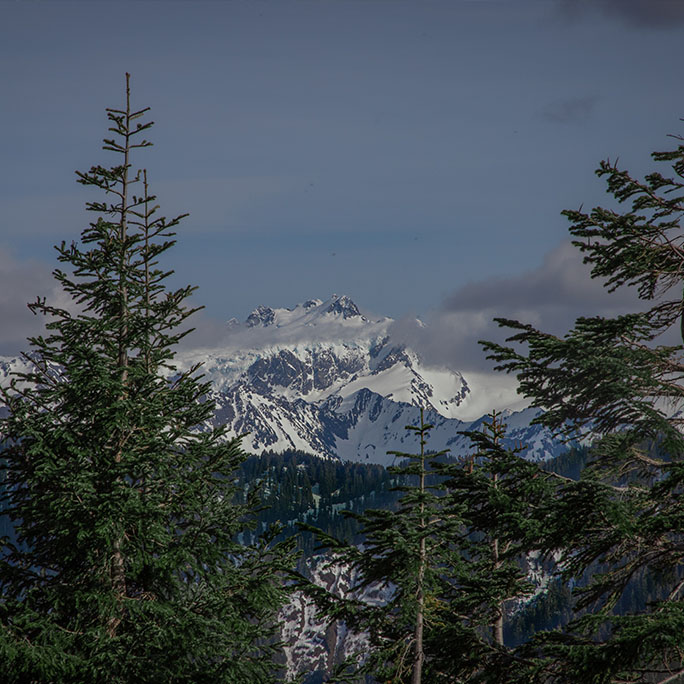 BRYANT MADE HIS FIRST attempt to get me to join him in Olympic National Park in August 2011, when I worked as assistant editor for Real Change, a weekly Seattle newspaper sold by vendors who are homeless or low-wage earners. (Portland has a similar newspaper, Street Roots.) Bryant was a Real Change vendor. He slept on top of a picnic table in a city park in North Seattle, and when it rained, he slept under the picnic table. When I heard about his photographic forays into Olympic, I interviewed him for the paper. Bryant was earnest, well-spoken, eccentric, and, judging by color slides he showed me, talented. I liked him.
BRYANT MADE HIS FIRST attempt to get me to join him in Olympic National Park in August 2011, when I worked as assistant editor for Real Change, a weekly Seattle newspaper sold by vendors who are homeless or low-wage earners. (Portland has a similar newspaper, Street Roots.) Bryant was a Real Change vendor. He slept on top of a picnic table in a city park in North Seattle, and when it rained, he slept under the picnic table. When I heard about his photographic forays into Olympic, I interviewed him for the paper. Bryant was earnest, well-spoken, eccentric, and, judging by color slides he showed me, talented. I liked him.
The interview lasted more than an hour, and when we finished, he asked if I wanted to go camping. I burst out laughing. Me, a black queer man with zero experience in the backcountry, hike miles into the wilderness? I told him I wouldn’t last three hours. He said he’d be my guide. It was a sweet offer, but I declined. Yet over the next few years, whenever I saw him, he kept inviting me. I always said no—until February 2015, when it struck me (in a way that might sound totally woo-woo) that maybe the rain forest was calling out to me through Bryant, that he was acting as a messenger. But what was the message? The only way to know was to visit the park. So I finally said sure, let’s go.
Some friends voiced caution: Was it safe, heading into the wilderness with a straight, white homeless man I barely knew? It was a valid question. Growing up, relatives and childhood friends taught me the woods weren’t safe for black people. The wilderness belonged to white folks, and any black person who ventured into their domain might not come back. If someone hurt me—or worse—while I was out there, I’d have only myself to blame. Those were high stakes. And while I understood the troubled American history that fueled those beliefs, I didn’t want to be constrained by racist ideas of what black people could or couldn’t do. Besides, Bryant didn’t scare me. Bears did.
In May 2015, after months of preparation, I drove us to the Bogachiel Rain Forest, the northernmost of four rain forests that mark the park’s western flank. During the drive, it was easy to hide my nerves about the trip since Bryant was consumed with another reality: He had told me he was a drinker, and afterweeks spent binging on malt liquor, our trip marked the start of him going cold turkey. In the van, Bryant guzzled a gallon of milk to settle his stomach, while his complexion turned sallow. On the trail, whenever we took a break, sweat cascaded down his face. Looking at him only made me more nervous.
We planned to stay a week. But that first night, as I lay in my (borrowed) sleeping bag in my (borrowed) tent, fear churned my mind. I knew I’d never see the beauty Bryant claimed was here unless something melted the terror inside me. I just didn’t expect that something to show up the next morning.
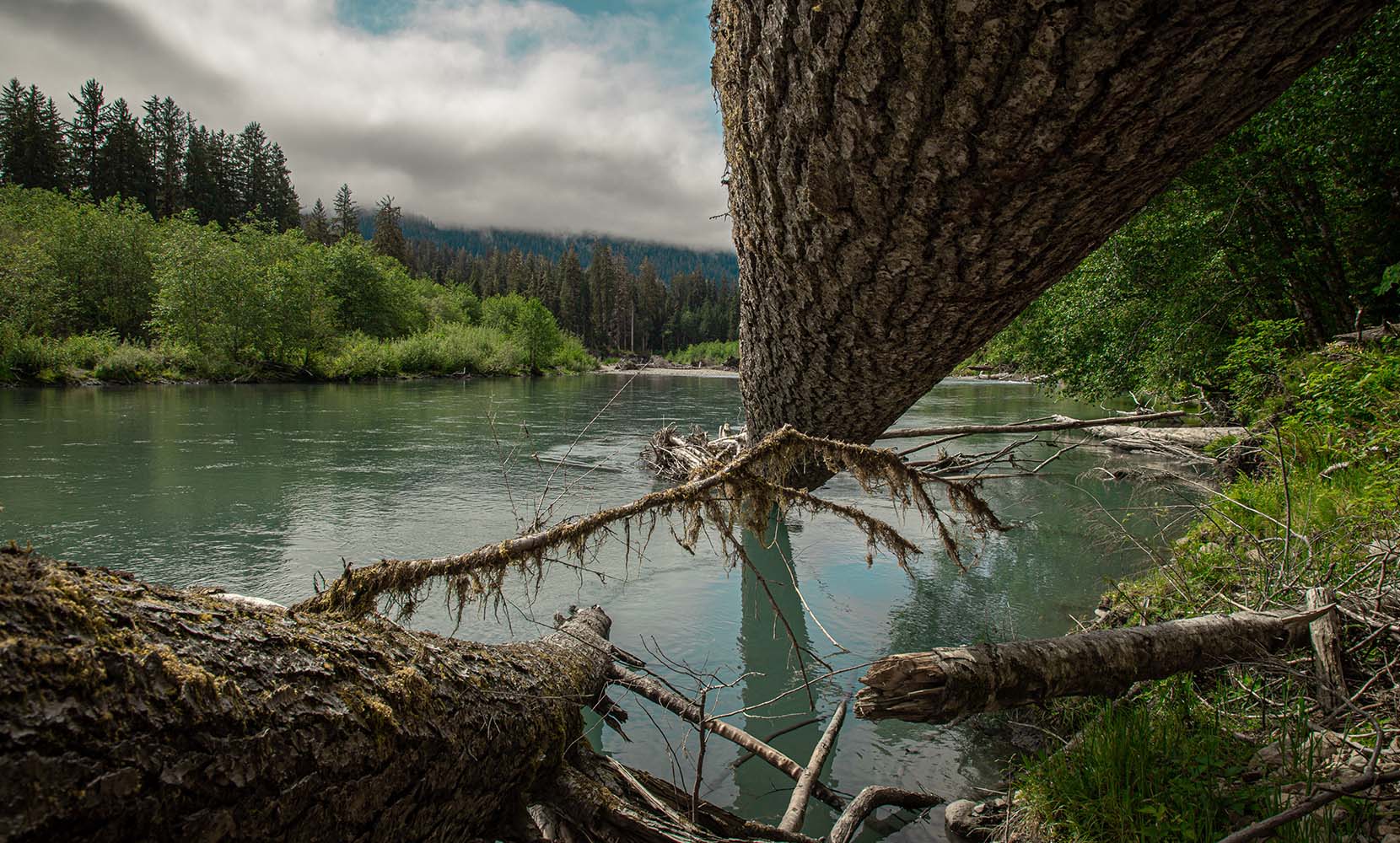
MOMENTS AFTER WE finished our riverside breakfast, Bryant said, “Think you’ll be all right if I leave you alone for a bit?”
My stomach hit my feet. Leave me alone? The trailhead lay some four miles behind us, and even though I knew we were on the Bogachiel trail, I couldn’t tell, when I looked at my map, precisely where in the park we’d pitched camp. I was lost without Bryant. And now he wanted to separate.
“Where are you going?” I asked.
A friend of his had worked as a volunteer ranger for the National Park Service, he said. She’d tucked her camp in the woods a mile or so back. He wanted to see if it was still there.
“Why can’t I go with you?”
She’d told him her camp’s location was secret. He couldn’t share it with anyone.
Not even me.
“Are you serious?”
Bryant nodded. I saw in his face, which had regained some color as he sobered up, that I couldn’t talk him out of leaving me alone. Even with my fear, I understood he was being faithful to his friend. I respected that.
He grabbed his backpack, camera, and tripod. “I should be back in an hour, hour and a half.”
“What am I supposed to do while you’re gone?”
“You can write in your journal.” Then he cast his free arm out to the wilderness like a carnival barker announcing the next act. “Or enjoy the view.” Seconds later, he left.
I pressed my back against a giant tree and slid to the moss-covered earth. That spring, the rain forest was in the grips of a drought, and the crispy moss stabbed through my pants. I barely noticed. My seat lay near a 20-foot drop-off with a clear view of the swirling Bogachiel River. I didn’t care. All I could think was a mountain lion might scale that drop-off and rip me to shreds.
Who knows how much time went by, maybe 15 minutes, but I couldn’t calm my thoughts. Around me were gigantic trees—some of the largest coniferous trees on earth are in Olympic—but I never noticed. The sky, the river, the nurse logs, and Douglas squirrels: They might as well have been invisible. All I saw was danger. What if something bad happened to me? Or worse: What if it happened to Bryant? What would I do? How would I get—
A loud buzzing surged past my left ear. I almost screamed. What the hell was that? All I could imagine was it was my death, coming for me in a national park. My life was over.
When my eyes focused, I saw it wasn’t death, but a Rufous hummingbird. The size of a plump apricot, he hovered six inches from my face. When he turned his head, the sun transformed his iridescent throat feathers into golden armor. The bird zigged away, then zagged back a nanosecond later to gaze at me with obsidian eyes. He hung in the air a good 15, 20 seconds, his wings a non-stop blur—until he pivoted and sped out of sight.
It took several moments to catch my breath and another few to realize the irony. I was so consumed with forecasting a terrible future I forgot to acknowledge the wondrous present. There, in a park so singular it’s the only UNESCO World Heritage Site in the Pacific Northwest, I was blind to a quality so many people seek: the beauty of the world.
Bryant returned about an hour later, and after describing his side-trip, he asked if anything had happened to me. I filled him in on the hummingbird. He grinned. “See? Didn’t I tell you this place was great?”
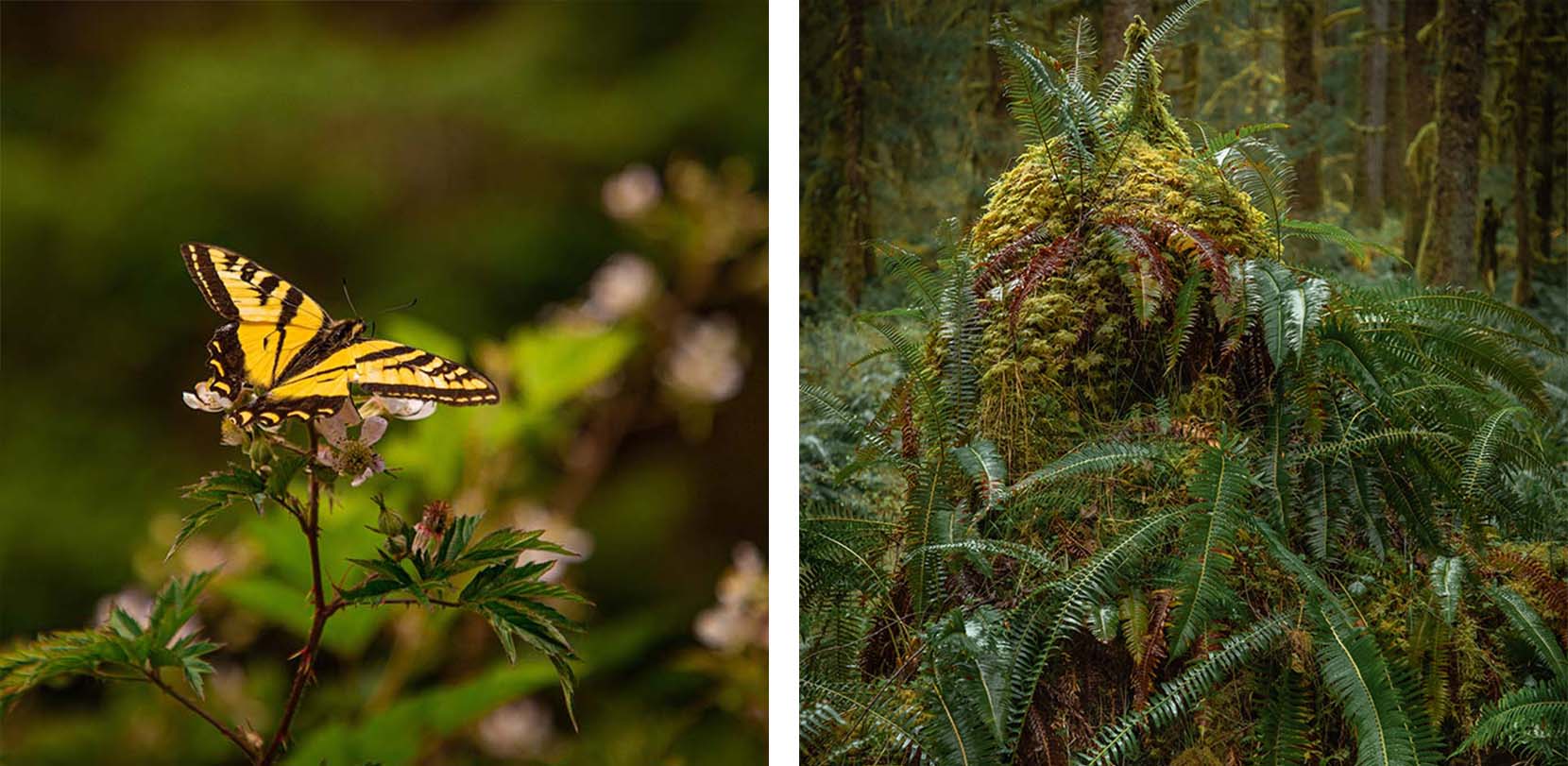
I WISH I COULD say that great feeling lasted the entire trip. It didn’t. New situations always tried to bully it into submission.
Our intention was to head deeper into the backcountry. Bryant mentioned that if we stuck to the main trail, we’d see nice trees, but if we forded the Bogachiel River and took another trail, we’d see incredible trees. I reminded him we’d chosen the Bogachiel because he said I wouldn’t have to worry about a river to ford. That made me happy because I’d never forded a river. The prospect unnerved me. He understood. He just thought…maybe…I’d be interested. I wasn’t. He proposed a test run.
“All right,” I said. “Let’s try.”
At the ford, he found a five-foot staff and showed me how to cross the riverbed’s slick stones: step, step, place the staff; step, step, place the staff. He was a good teacher, clear and direct. He handed me the stick and told me to take my time, not to rush. The river spanned some 20 yards. From the shore, I ventured about two yards into the Bogachiel, but when the water’s pace nearly toppled me, I turned right around. I felt like a failure.
The next day, we forded the river for real. Bryant kept balance with his tripod while I used the staff. The water crested mid-thigh. I almost slipped, twice, but somehow I made it.
“Hey,” he said. “You just forded your first river.” He seemed proud.
I followed him down the alternate trail. Less than 100 yards into the woods, I realized Bryant was right. We’d entered a valley of giant trees. Their grace humbled me.
From our new basecamp, we journeyed out once in the morning and once in the afternoon. We bushwhacked through red alder branches and stomped through creeks. My waterproof hiking boots stayed sopping wet.
But for nearly every frustration, there came an equal, or greater, reward. Bryant wanted to ford the river in a different spot, to shoot one of his favorite water pools. We crossed, and bisecting the trail lay a downed red cedar, its trunk so massive we had to clamber around it. When I leaned in to examine the drying sapwood, its resinous aroma made me smile.
Another day, as Bryant wandered the trail in front of me with his camera, his right hand shot up in the air: a signal to stop.
“What?” I asked.
“Elk,” he whispered.
“Where?”
He pointed. All I saw were sword ferns. Then a female elk raised her head. She froze. Behind her, a second elk lifted a foreleg. She set it down. She stood still. A third elk moved. And a fourth. For almost 10 minutes, their buff hides rose from and receded into the green as they passed before us. A Pacific wren trilled. It was magical.
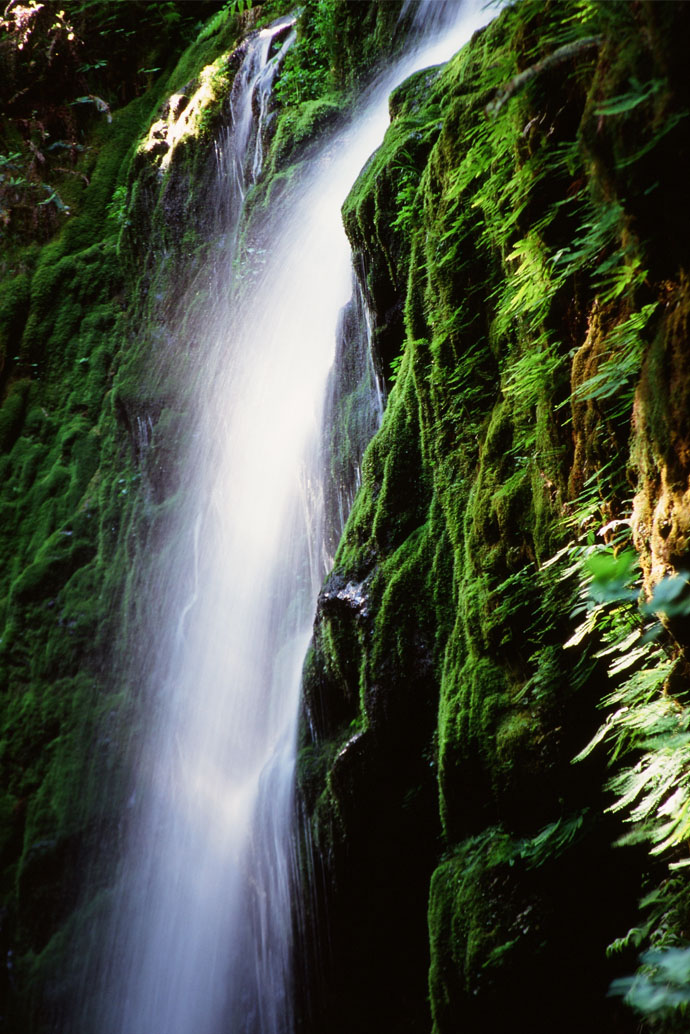 BUT MAGIC CAN BE exhausting, and Olympic wore me out. In that week, Bryant estimated we covered 70 miles, most of it off-trail. The last afternoon, I expected to rest. Not Bryant. Invigorated after a week of not drinking, he wanted to use up every minute.
BUT MAGIC CAN BE exhausting, and Olympic wore me out. In that week, Bryant estimated we covered 70 miles, most of it off-trail. The last afternoon, I expected to rest. Not Bryant. Invigorated after a week of not drinking, he wanted to use up every minute.
Earlier on the trail, he’d noticed a rivulet crossing our path. To me, it was just water. To Bryant, it was a sign. He suspected that hidden deep in the woods lay the rivulet’s source, which he guessed was a waterfall. My map didn’t indicate any water where he wanted to go, but Bryant didn’t care. So when he suggested we head off-trail to find this hoped-for waterfall, I nearly lost it. Was he nuts? But as he set off, I knew it was catch up or stay at camp.
Bryant broke through underbrush and stormed up a steep hill. I tried to mimic him but kept slipping to the bottom. When I reached the top, panting, he told me we’d gone the wrong way. Time to turn around. He backtracked, confident as he struck out on another route. I tripped over a root. He scurried up a ridge. I crawled on my knees. He salamandared over a damp, enormous rock and disappeared. I cursed his name. Too far in to turn around, I kept going, exasperated and winded. Just when I was ready to give up, I heard, off to the left, water. I slid into a small crevasse and hoisted myself up the other side. By then I could feel the temperature drop. I snaked around a tree and stood slack-jawed at a waterfall nearly 100 feet high. The water tumbled over the edge in a riotous ivory plume. Droplets misted my glasses.
As if on cue, a shaft of sunlight struck the top of the falls, and the air seemed to dance with diamonds. Bryant took a dozen photos, and then we both sat in awe. Time disappeared. It was one of the most beautiful experiences of the trip.
As we left the next day, I felt a swirl of emotions: thrilled I’d made it out safe, sad the adventure was done, and mournful that while I’d be returning home, Bryant—who I realized had become my friend—was heading back to a gritty urban park, to face countless nights of homelessness. I couldn’t overlook that a man many people would disdain had given me a chance to see the world in a new way.
And along with the dirt and grime and smelly boots, I knew I was taking something else with me: a reminder that beauty exists in more than a tree or slug or waterfall. Beauty exists in people, too.
ROSETTE ROYALE is a Seattle-based writer and storyteller. He’s working on a book about his experience exploring Olympic National Park’s temperate rain forests with photographer Bryant Carlin.
